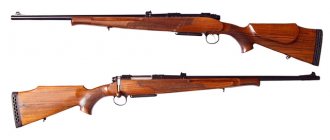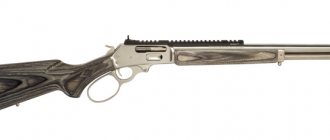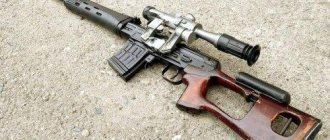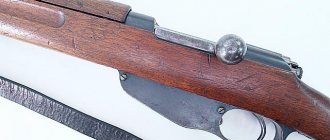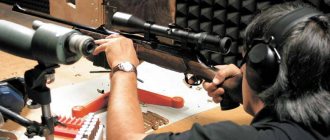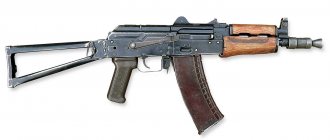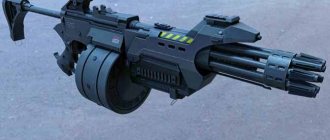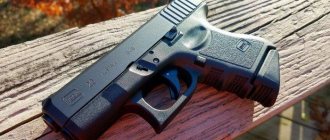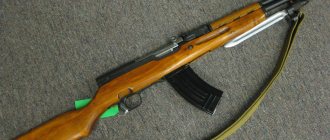Stocks and stocks
The stock of a rifle, carbine, machine gun, submachine gun, light machine gun is one of the main parts of a handgun.
The stock allows you to point the weapon at the target and is designed for ease of handling the weapon. It serves to connect all its parts and mechanisms into a single whole. The stock should provide ease of handling of the weapon both during shooting and in hand-to-hand combat, speed of aiming, and reduce the effect of recoil on the shooter’s shoulder when firing. Shpagin PPSh submachine gun mod.
1941 with a wooden stock with a semi-pistol grip. The shape, design of the stock and requirements for it have been improved throughout the history of the development of small arms. As a result, a unique classic look and shape of the stock was developed.
In accordance with this, a number of requirements are imposed on the stock, the most important of which are the following: the stock must have a shape and size that ensures ease of handling of the weapon in all cases of its use, and be sufficiently strong with the minimum possible weight; the material of the stock must have good resistance to moisture (this requirement is extremely important, since the stock affects the shooting accuracy and stability of the weapon); the design of the stock must ensure a uniform position of the barrel and receiver, which does not change during operation, as well as during disassembly and assembly; the stock should be simple in design, economical and made from non-scarce material.
Fulfillment of these requirements is ensured by the correct choice of stock design and the use of appropriate material for it. The material of the stock must be light, durable and non-hygroscopic. For many centuries it was made only from wood. Since the end of the twentieth century, plastics have also been used for its manufacture. Previously in Russia, stocks were mainly made from birch wood blocks. However, along with this, stocks for hunting rifles were produced from higher quality, but also more expensive hard wood (walnut, beech). Sometimes they used apple, elm, hornbeam, maple, and pear trees. The best material for a stock is walnut, especially butt walnut. The preparation of blanks was carried out only in winter. Blanks prepared at other times of the year had poorer mechanical properties and were therefore unsuitable for making stocks. The quality of wood was determined by its color: birch wood should be pure white or pinkish-white, and walnut wood should be dark brown.
The wood had to be fine-grained (large-grained wood is softer), seasoned, straight-grained, without knots. In birch and walnut blanks, only healthy branches in the butt were allowed - with a diameter of no more than 25-30 mm, located no closer than 25 mm from one another. On the neck and forend of the stock, untwisted branches with a diameter of no more than 13 mm were allowed. The direction of the fibers in the blank had to be straight along its length. Straightness is especially important in the neck, the most fragile part of the stock. The blanks for the stocks were air-dried until dry.
The production of stocks for military and hunting weapons differed in technology.
The requirement for the minimum sensitivity of the material of a military-style small arms stock to moisture was ensured by the fact that it was made on a copying machine with subsequent grinding. In this case, the outer surface of the stock was cleanly processed, impregnated with pine resin or a 5-10% solution of petroleum bitumen in mineral oil (giving the surface a brown color) and varnished. This treatment of wood made it non-hygroscopic, thereby protecting it from swelling and subsequent shrinkage. In addition, wood impregnated with resin was protected from rotting and insects. The varnishing gave the stock a beautiful appearance.
Fixation unit for a wooden folding wooden butt in a Kalashnikov RPKS light machine gun
Since the production of hunting weapon stocks was not carried out in such massive quantities as military ones, their production took into account the specific features of such weapons. The stock of a hunting weapon was first roughly ground with a file, then with sandpaper. After this, they moistened it with water to remove any wood dust remaining after sandpapering. Finally, the stock was polished with pumice, wetted again with water, dried, and then impregnated with linseed oil or natural drying oil. Drying oil filled the pores of the wood, protecting it from the effects of weather conditions and at the same time giving it color. After this, the surface of the stock was polished with shellac diluted in alcohol. It was applied several times in a thin layer to the surface and thoroughly rubbed with a swab. After each coat was applied, the stock had to be dried. Sometimes wood was stained before being coated with shellac or drying oil.
The design of the stock must satisfy an extremely important requirement - ease of aiming. This requirement is met by the presence of a bend in the neck of the stock. In the absence of bending, it would be extremely inconvenient to aim, especially at low elevation angles.
Modern small arms use a straight neck, but ease of aiming is ensured by lifting the sighting devices onto special handles for carrying weapons or by installing optical sights. However, this approach increases the recoil force into the shooter's shoulder. In addition, the amount of tilt of the stock neck affects the component of the recoil force directed at the shooter's shoulder and the overturning moment of the weapon.
Stocks made of wood have a number of significant disadvantages. They are not strong enough, they swell from dampness, and when dry they warp, which affects shooting accuracy and complicates the conditions for degassing the weapon.
In this regard, attempts have been made repeatedly to replace the wooden stock with a metal one - made of steel or light alloys, which would have the same positive properties as a wooden one, but would eliminate these disadvantages.
However, the metal stock turned out to be somewhat heavier than the wooden one and, due to its greater rigidity, the feeling of recoil increased; in addition, the cost of the stock increased significantly, and thermal insulation of the stock (production of special gaskets) was required to protect the shooter’s hands from burns, since the metal stock is subject to heating during shooting. In the 1930s, experiments were carried out in Germany on the production of metal stocks for Mauser 98 k carbines. The metal used to make them consisted of a silicon-magnesium aluminum alloy. This alloy had a low specific gravity. The outer surface of the stock was covered with a layer of thermal insulation. The weight of this stock remained almost the same as that of a stock made of walnut wood, and the strength was higher. The stock in the Italian modernized Mannlicher-Carcano rifle, which was in service with the navy, was made from the same metal. However, the metal stock has not received widespread use in repeating rifles. In the 1950s-1960s, a number of experimental works on the creation of plastic stocks were carried out in different countries. The operation of such a weapon showed that it was not the most successful material for a stock. Plastic, unlike wood, was then considered to be “cold” and “dead.” In addition, in severe frost, the plastic stuck to the skin, and some varieties warped at high temperatures. However, the first sample of the American low-impulse 5.56-mm assault rifle AR 15/M 16 with a plastic split stock was adopted by the US Army already in 1963, despite the insufficient service strength of the butt and fore-end. Dragunov SVD sniper rifle with a frame-type wooden butt and a removable adjustable “cheek”
The single stock consists of three elements: a butt designed to rest the weapon on the shoulder; a forend for supporting the weapon with one hand and a neck connecting the butt to the forend. The forend is that separate part of the stock that is mounted under the barrel. If the forend is made separately from the butt, then the stock is often understood as a butt with a neck.
The rifle stock was a part with many cutouts and windows in the area of the forend for laying the barrel with the receiver, securing the safety bracket with the trigger mechanism and the magazine. The front part of the stock, called the forend, served to house the barrel with the receiver, to protect the barrel from damage due to accidental impacts, to protect the shooter’s hands from burns when the barrel was very hot and from freezing during shooting in severe frosts. The transverse dimensions of the forend at the point where it is grasped by the left hand were set based on considerations of the convenience of holding the weapon with the hand; the transverse dimensions of the rest of the forend were determined from strength conditions.
The fit of the fore-end to the barrel was always uniform and uniform, since the non-uniform position of the barrel in the fore-end (for example, local fits) changed the nature of the barrel's vibrations, which affected shooting accuracy. The depth of the groove was such that the upper edges of the forend were at the level of the axis of the barrel. For example, in the Soviet 7.62 mm repeating rifle of the 1891/30 model. the forend of the stock was adjusted either so that it evenly touched the barrel over the entire mating surface, or so that there was a uniform gap. This adjustment protected the fore-end from the leash, since the birch stock, depending on atmospheric conditions, could swell significantly and, when dried, not take its original shape. In rifles equipped with a walnut stock, the fore-end groove was fitted to the barrel with a gap of 0.5 to 1 mm on each side. A walnut stock is subject to deformation to a lesser extent than a birch stock, which made it possible to make adjustments with a similar gap; at the same time, the accuracy of fire increased slightly.
The upper part of the barrel, which is located in the forend, was covered with a barrel lining, which served to protect the shooter’s hands from burns. The barrel lining was made from the same wood as the stock and was fitted to the barrel with a gap.
The neck of the stock is the part connecting the fore-end to the butt.
The neck serves to hold the stock with the right hand when shooting and during a bayonet strike. The cross-section of the neck has an oval shape for comfortable clasping it with your hand. The neck at its thinnest point has a circumference of 12-13, sometimes 10.5-11 cm. Depending on the shape of the neck, stocks are straight (otherwise - rifle, English), in which the lower line of the neck and butt coincide so that the lower line of their the neck is a continuation of the bottom line of the butt. In some types of weapons, a small protrusion is made at the bottom between the neck and the butt, providing a more comfortable grip of the neck with the hand. This stock is called a pistol stock. SVDS sniper rifle with a folding metal stock.
A stock is a part of a stock or a separate assembly unit of a small weapon, designed directly to rest the weapon on the shooter’s shoulder when firing and for hand-to-hand combat. The butt is part of the stock from the neck to the rear section. A metal back is mounted on the end of the butt, which protects the end of the butt from cracking and increases its strength. The back of the butt, pressed against the shoulder during a shot, has a significant area so that the force caused by the recoil of the weapon is distributed over a larger surface of the shooter's shoulder and is less sensitive. For this purpose, some modern samples make rubber linings (shock absorbers). The butt should not have sharp corners, especially in the place where it touches the shooter’s cheek. The length of the butt is set based on the comfortable position of the weapon in the hands. The left hand should hold the weapon approximately at the location of its center of gravity; in this case, the shooter’s right arm should not be strongly extended or bent. Muscle tension in the arms should be minimal, since strong muscle tension is accompanied by trembling of the weapon during aiming, which leads to poor shooting results.
There are known attempts to manufacture butts that are adjustable in length, which complicates the design, and even to adjust the length of the butt to the shooter (English L42 sniper rifle).
To increase the strength of the rifle stock, a set of weapon parts was used, serving both to increase the strength of the stock and to protect the trigger from accidental impacts, as well as to fasten the barrel to the stock. These parts were called a device. They consisted of a metal butt cap attached to the butt of the butt to protect the butt from being knocked down when hitting the ground, etc.; metal tips fixed at the end of the forearm and at the ends of the receiver lining; metal eyes, which were used to fix through holes in the stock, used for threading the running belt; stock rings that serve to fasten the barrel lining to the fore-end of the stock.
The back of the head was usually made of mild steel and was either painted or blued to prevent rust. Eyes and tips were made of either brass or mild steel.
The trigger was protected from accidental blows using the so-called trigger guard, the cylinder of which crashed into the stock at the location of the trigger.
To connect the barrel to the stock, as a rule, a tail rotor, a stop screw and rings were used. The tail screw passed into the hole in the tail of the box, passed through the wood of the stock, screwed into a threaded hole in the trigger guard and thus made it possible to tightly pull the tail of the box to the wood of the stock. The stop screw was located in front of the magazine. When assembling the rifle, loose tightening of these screws was not allowed, since this increased the dispersion of shots and the stock could split behind the stops due to the barrel moving along the fore-end of the stock when fired.
Stock rings used in various types of rifles were divided into two types according to their design: blind, i.e. the internal dimensions of the ring, which always remained constant, and sliding ones, allowing you to change the dimensions using a screw.
The stock rings had to be installed uniformly on the weapon and not be overtightened.
In practice, this uniformity was difficult to achieve, resulting in uneven rifle combat when shooting. Therefore, most samples of repeating rifles were equipped with blind rings. Kalashnikov AK-74M assault rifle with a folding plastic stock and fore-end
The stock as a separate assembly unit is included in such domestic weapons as the SVD sniper rifle, Kalashnikov AK/AKM/AK-74 assault rifles, Kalashnikov RPK/RPK-74 light machine guns and uniform Kalashnikov PK/PKM machine guns (except for tank ones).
Butts are divided into the following types: fixed, folding (folding), detachable.
Most modern models of domestic small arms (AK, AKM assault rifles, RPK machine guns and SVD rifles) have separate stocks, consisting of fixed wooden stocks and a separate forend. The advantages of such butts are the ease of use of weapons in hand-to-hand combat and increased stability when shooting, provided by a fixed wooden butt. A wooden stock generally has a socket for accessories and a metal back with a lid over the socket. The socket has a spring for pushing out the pencil case with the accessory.
Many submachine guns of the mid-twentieth century had wooden stocks (for example, PPD, PPSh), which were basically similar in purpose and design to rifle stocks. But the desire to obtain smaller dimensions for ease of transportation and operation from the hatches of a tank or other shelter led to the design of submachine guns with folding (folding) metal butts (for example, MP-38/40, PPS). This design of folding stocks directly influenced the further evolution of this important part of small arms.
Thus, the AKS, AKMS assault rifles and RPKS light machine guns, created in the late 1940s and early 1950s, received folding stocks, making them easy to handle in tanks, combat vehicles, and helicopters.
Folding stocks can be made in the form of a folding wooden, metal or plastic butt, differing from a fixed butt by the presence of a hinge and a spring-loaded latch (for example, the RPK machine gun, AK-74/AK-74M assault rifles), or in the form of a folding metal butt (for example, AKS/AK-74M assault rifles). AKMS).
A little more detail about the evolution of the buttstock in Kalashnikov assault rifles.
The first sample of the 7.62-mm Kalashnikov AK assault rifle, created in 1947, had wooden parts - separate buttstock, fore-end and barrel guard, as well as a pistol grip fire control. They were made from birch blanks and covered with three layers of varnish, which ensured their sufficient resistance to swelling in damp conditions.
Two variants of the Kalashnikov assault rifle were adopted by the Soviet army: - for infantry - AK with a permanent wooden butt, which ensured better stability of the weapon when firing and made it possible to strike with the butt in hand-to-hand combat;
- for special forces and airborne forces - AKS with a metal butt that folds down - forward under a wooden fore-end. The folding stock in the landing version of the AKS largely copied the design of a similar stock and its latch, which was well proven during the war years, used in the German MP.38/MP.40 submachine guns. Silent automatic pistol APB with a detachable metal shoulder rest (butt)
However, soon the wooden parts of the AK assault rifle underwent major alterations. The reduction in the cost of their production was facilitated not only by the new technology for the production of the butt and forearm, where birch blanks were replaced with slabs of laminated plywood, and the barrel linings were now made by stamping from laminated veneer, but also by a simpler attachment of the butt. Instead of the butt clip used in the previous model, a butt plate with two shanks was used, which was attached to the receiver not with rivets (as in the first model of the serial AK in 1949), but by welding. This design not only reduced manufacturing costs, but also made the weapon more durable in hand-to-hand combat.
One of the areas for improving the 7.62-mm Kalashnikov AKM assault rifle in the 1960s was to reduce the cost of its production through the use of new advanced materials, and in particular plastic. They produced a batch of machine guns with plastic stocks and sent them to the troops. Some went to the hot south, some went to Siberia... Soon the first negative answers came... In Central Asia, in the sun, plastic gets so hot that you can’t even hold it in your hands. In Siberia, in the cold, your cheek sticks to the butt, it’s impossible to lean it against it. Designers were again forced to return to cheap plywood, which had sufficient strength and moisture resistance.
But soon we had to return to this work again. New 5.45 mm Kalashnikov assault rifle mod. 1974 was produced in two versions: - for motorized rifle troops - AK-74 with a wooden butt, and a metal back was installed on the butt, with transverse ribs to increase the grip of the butt with the shoulder; — the AKS-74 assault rifle with a metal folding butt that folds to the left along the receiver was intended for the airborne troops. The triangular shape of the metal butt provided it with the necessary rigidity.
During the production and operation of AK-74 assault rifles, which went through the harsh school of war in Afghanistan in 1979-1989, a number of shortcomings were identified in these weapons, which were gradually corrected. Among other shortcomings of the new weapon, numerous complaints from “Afghan” soldiers were caused by the wooden butt and fore-end, covered with several layers of varnish. The soldiers, who first encountered the specific climatic conditions of Afghanistan, had the opportunity to learn a lot of new things. Thus, high temperatures, reaching +50 degrees Celsius in the shade in the summer, caused the varnish on the wooden surfaces of the AK-74 to soften, and it flowed onto the shooter’s hands, which repeatedly led to various dramatic situations and was especially unpleasant during tense moments of battle. Therefore, most of the weapons used in combat units, almost immediately after being issued to the personnel, were subjected to independent finishing by soldiers by scraping off the varnish. At the same time, the absence of thermal insulating linings on the folding metal butt of the AKS-74 caused certain inconveniences at low and high temperatures when the weapon came into contact with the shooter’s cheek. Therefore, in order to avoid such “overlays,” soldiers had to wrap the butt with a rubber band or electrical tape.
VSS sniper rifle with a removable wooden frame-type butt
The designers found a way out of this situation by proposing to manufacture the butt, fire control handle, fore-end and barrel lining for assault rifles and machine guns from impact-resistant glass-filled polyamide, initially AG-4S, and later replaced by the more technologically advanced AG-4B . The heat transfer coefficient of the new material was no higher than that of wood, so burns to the shooter’s hands during prolonged shooting were excluded. In addition, polyamide has increased resistance to abrasion and impact loads, eliminating the risk of chipping and splitting.
At the end of the twentieth century, this weapon, while retaining all its best qualities, acquired a number of new properties that significantly improved its combat and operational characteristics. The main feature of the new model of the 5.45-mm AK-74M assault rifle was a plastic butt that folds to the left, replacing the metal folding one. On the left side of the butt there is a rectangular groove into which, when folded, the bar of a standard fastening unit fits. The handguard and the barrel lining of the gas tube of the AK-74M assault rifle are also made of glass-filled polyamide AG-4V, which has increased resistance to abrasion and shock loads.
In modern models of small arms, when making stocks, a departure from the classical form is allowed. So, to reduce the toss of the weapon, the neck is made straight, and for the convenience of holding the weapon, an additional pistol grip is introduced. Recently, the layout of individual small arms according to the “bullpup” scheme has become very popular, which involves moving the moving parts of the automation and trigger mechanism into the butt and installing a pistol grip in front of the magazine to reduce the overall length of the weapon. To reduce the tossing of the weapon under the influence of recoil, it is planned to move the butt to the line of the axis of the barrel bore (according to the “linear recoil” principle).
The shape of the butt of light machine guns is determined mainly by the convenience of aiming and fire control and the desire to reduce the impact of recoil force and the impact of the moving parts of the automation in the rear position on shooting accuracy. The latter is achieved by bringing the shoulder rest as close as possible to the line coinciding with the continuation of the axis of the barrel bore. Metal folding stocks are rare in light machine guns. Currently, they have been replaced by plastic stocks.
Along with fixed and folding stocks, detachable stocks have also received some development, which are used in the Mauser K-96, Astra M 900, Stechkin APS pistols, as well as in the 12.7 mm NSV heavy machine gun. At the same time, the Mauser K-96, Astra M 900, APS pistols have detachable butts in the form of a holster - a butt, which with its latch is attached to the pistol when firing bursts at maximum ranges.
Sergey Monetchikov Illustrations from the author’s archive
[=16pt] Complete restoration[/]In some cases, it is necessary to completely renew the coating of a weapon stock. This can happen, say, if a poorly preserved collector's item was purchased, or to update a double-barreled shotgun after a long period of careless use. If for some reason you do not want to give the tree even to your trusted gunsmith, who, of course, will return it to you as new, in exchange for a very decent amount, you can act at your own peril and risk. Only in this case does it make sense to use what is described further in this article. The first operation is to remove all metal parts from the stock; the only exception is the bushings that pass through the stock of a rifled weapon. Once removed, the stock (along with the fore-end, if we are talking about a shotgun) requires freeing from the remnants of the previous processing. Then you can go in two ways. For stocks impregnated with oil or paraffin, as often happens with military weapons, you can use boiling water, neutral soap and a fairly stiff clothes brush, alternating vigorous washing with drying in the sun so that the oil with which the wood is saturated comes out. In the most difficult cases, as happened recently with the Enfield Trainer 22 caliber rifle, you can use a brush to wet the stock with some kind of volatile solvent. Aviation gasoline or much better methyl ethyl ketone will do. When the oil no longer appears on the surface, you can move on to the next stage - the actual restoration of the wood. For varnished or not heavily oiled stocks, the solution may be to use a suitable quality solvent, which should be applied generously with a brush, being careful not to miss any spots. Do not forget about precautions when working with solvents - work only outdoors wearing rubber gloves and a heavy oilcloth apron. And most importantly, wear protective glasses, preferably the paintball type. The reason for these precautions is clear: varnish thinners are gels based on acetone and caustic soda. After leaving the solvent on the bed for at least 15-20 minutes, the dissolved mushy products must be removed with a metal spatula, being careful not to scratch the wood. After this, you need to thoroughly rinse the butt in soapy water, not forgetting about yourself. Polyester-based varnishes are the most difficult to remove, as they are quite resistant to solvents. An industrial hair dryer and a scraper will help solve the problem, just don’t overdo it - you can easily damage the wood! Now you can start restoring the surface, removing dents, scratches, abrasions and chips. Dents can be repaired by forcing the dented wood to straighten out. To achieve this result, there is a proven method. Using a cotton swab, apply a mixture consisting of equal proportions of water and denatured alcohol or water and glycerin in several passes. When the wood is well soaked, place a piece of cotton cloth on the place where there is a dent, and then place the tip of a well-heated soldering iron on top. For deeper dents, this operation must be repeated 3-4 times to obtain a satisfactory result. Very large areas with dents can be treated with a steam iron, again remember to use a cotton cloth and be careful that your wife or mother does not catch you doing this. Scratches and abrasions of the entire surface are removed using sandpaper. Avoid simply sanding by hand and at the same time do not apply sandpaper to a hard substrate, for example, a wooden block - the surface of the stock always has some degree of curvature, and in this case it is easy to disrupt their original profile. It is advisable to purchase a soft abrasive swab or make a “sandpaper” at home, that is, a wooden block measuring 50x100 mm with two grooves on the side surfaces for easy holding. A piece of neoprene or rubber about 5 mm thick should be glued to the lower plane of this block. On this surface you need to apply sandpaper with a grain size corresponding to the depth of the scratches. It is best to use corundum abrasive. Numbers from 60 to 120 are suitable for this. After this, you need to go over the surface in a circular motion with a soft abrasive swab until the scratches completely disappear. Then, using increasingly finer sandpaper, it is necessary each time to completely remove the deeper marks left by the previous, coarser one. Thus, you need to reach at least number 400. Finally, by installing a rubber circle on the drill and attaching a sheepskin cover to it, you can finally polish the surface of the wood using the finest abrasive powder.
